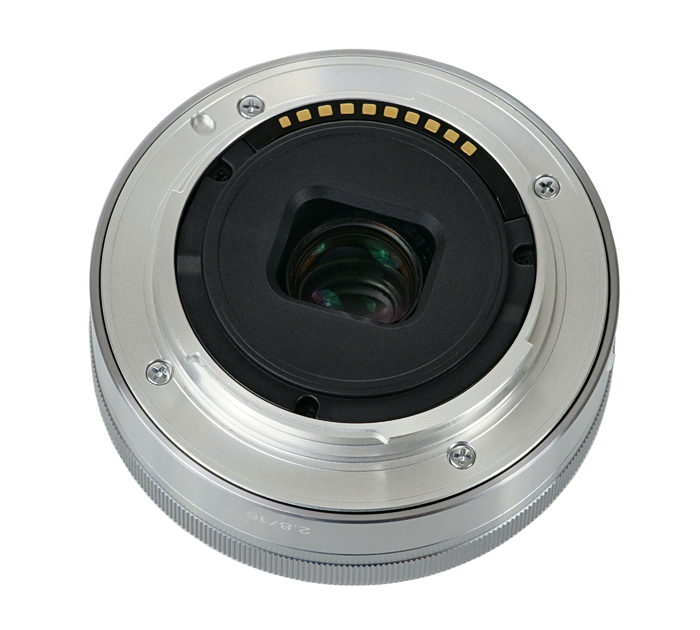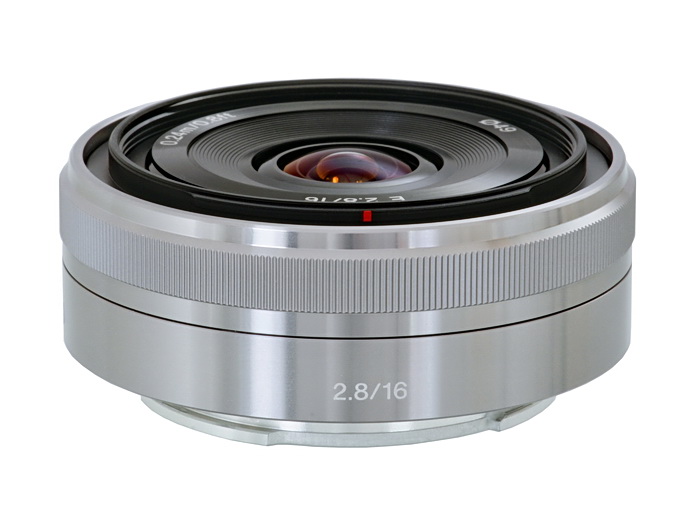Here’s a brief look at the Sony NEX 16mm F/2.8 lens. Scroll down for the main review.
|
Lens
|
Sony NEX E-mount 16mm F/2.8 SEL16F28
|
|
Box contents
|
Front and rear caps and a user’s manual.
|
|
Cost
|
$250, or an extra $100 with camera as a kit.
|
|
Build quality
|
Very good, but super light-weight.
|
|
Additional information
|
Introduced in 2010. Has a focus motor inside similar to SSM, not the cheaper SAM.
|
| Specifications below |
|
|
Optical configuration
|
5 elements in 5 groups
|
|
Angle of view
|
83° APS-C
|
|
Aperture
|
7 blades, almost straight
|
|
Full frame and APS-C
|
APS-C only, and will only mount on E body cameras. Equivalent to 24mm of coverage due to APS-C crop factor of 1.5x.
|
|
Depth of field and focus scales?
|
Nothing.
|
|
Minimum focus, image plane to subject
|
9.4″ (0.24m)
|
|
Minimum focus, end of lens barrel to subject
|
7.25″ (184mm)
|
|
Hard stop at infinity focus?
|
No
|
|
Length changes when focusing?
|
No
|
|
Focus ring turns in AF?
|
No
|
|
Filter size
|
49mm
|
|
Filter ring rotates?
|
No
|
|
Distance encoder?
|
Yes
|
|
Max magnification
|
0.078x, or 1:13
|
|
Min. F/stop
|
F/22
|
|
Sony teleconverter compatible?
|
No
|
|
Length changes when zooming?
|
N/A
|
|
Dimensions WxL (my measurements)
|
2.45″ x 0.89″ 62mm x 22.5mm.
|
|
Maximum extended length (my measurements)
|
0.89″ (22.5mm)
|
|
Weight bare (my scale)
|
2.3oz (65g)
|
 |
| Front element |
 |
| Backside mount |
 |
| side shot |
 |
| Sony MTF chart and X-ray view |
Accessories for this lens. The wide-angle converter will give an equivalent coverage of 18mm. There is quite a difference between 18mm and 24mm! The fish-eye converter turns the lens into a 10mm (16mm equivalent) fish-eye lens. One last accessory to mention is the all glass, multi-coated (5 elements in 4 groups) optical viewfinder built specifically for the NEX 16mm F/2.8 lens.
The NEX 16mm F/2.8 lens has five elements in five groups, including one surface aspherical element. It’s build solidly, has a smooth manual focus action and a silent auto-focus motor which is great for keeping focusing noise out of movies. Due note this lens does not have OSS or built-in optical steady shot. Being a wide-angle lens, the benefits of image stabilization are not as pronounced as they are on a longer lens because the stabilization system doesn’t sense all that much movement with such a large area of coverage. Sony marketing probably opted for less cost, and possibly less size when they decided to leave out OSS. Also noticeable in the backside product shot above is the new NEX 10 pin contact patch, instead of the normal 8 (or 5 before distance integration and SSM) used on the Sony alpha system. The increase in connections allows the camera and lens to communicate more information.
Fit and finish are very good. The lens appears to be clad in metal, and has a metal mount, but is extremely light-weight and almost seems like it could be a mock-up, with no glass or internals. It uses 49mm filters, just like the NEX 18-55mm. The color is silver, like stainless steel, but seems to turn color slightly with a different angle of light, see product shots above. Sony claims this lens has a circular aperture, but due to the tiny physical aperture opening, the out-of-focus highlights or background blur is rendered seven-sided, not circular, unless the lens is wide open. Check out the Bokeh crops to see what I’m talking about.
 |
| Weird wave distortion |
|
16mm F/2.8
|
16mm F/4
|
 |
 |
|
16mm F/5.6
|
16mm F/8
|
 |
 |
Bokeh is somewhat harsh, producing a noticeable ring around highlights, but looks a little better stopped down. Starting in the F/4 crop, you can clearly begin to see heptagons, indicating the aperture isn’t round. Usually, a circular aperture is round at least one stop down from maximum, or wide open, but here the aperture is so small, the blades don’t have enough curve built-in. Crops are from the center of the image, about 10′ (3m) behind the focus point.
|
16mm F/2.8
|
16mm F/4
|
 |
 |
Coma is barely visible in this 100% corner crop, and then only when using the largest aperture.
|
16mm F/5.6 sun out of image
|
16mm F/11
|
 |
 |
|
16mm F/5.6
|
16mm F/11
|
 |
 |
I see some green ghosts when the sun or very bright lights are inside the image. I also see some flare from the sun, (washed out area) noticeable in the top left shot, on the left side, the sun is well away from the edge of the frame. Use of a hood probably would’ve eliminated this issue, or holding your hand out to block the sun.
|
16mm F/2.8
|
16mm F/4
|
 |
 |
Below are crops from the image centers.
|
F/2.8
|
F/4
|
 |
 |
|
F/5.6
|
F/8
|
 |
 |
|
F/11
|
|
 |
Intentionally left blank
|
|
F/2.8
|
F/4
|
 |
 |
|
F/5.6
|
F/8
|
 |
 |
|
F/11
|
|
 |
Intentionally left blank
|
At the mid-section, (about halfway between the center and corner area) sharpness suffers compared to the centers. The crops above show a soft mid-section unless stopped down to F/5.6. The image periphery is noticeably soft at normal viewing sizes when the lens is set to F/2.8, even when used in low light, such as night time street shooting. You may ultimately get better shots by raising the ISO and using a smaller aperture like F/4.
Below are the corners.
|
F/2.8
|
F/4
|
 |
 |
|
F/5.6
|
F/8
|
 |
 |
|
F/11
|
|
 |
Intentionally left blank
|
 |
| F/8 color fringing on left side of image, about 1000 pixels in from the edge |
Let’s check out the macro capabilities of this lens.
 |
| As close as you can get. F/5.6. No larger image |
Now for the conclusion.
This lens was designed for the purpose of being pocketable, inexpensive, and a platform for a couple of add-on converters, like a fish-eye and ultra wide. Sony did a good overall job with this lens, and I would consider the optical results good, but not great. Let’s ponder the good things; sharp in the centers, even wide open; very compact, and able to fit in the front pockets of relaxed fit jeans, or in a womens purse; and very low noise when focusing, which is great when shooting video. A few things that could be changed for the better, say in version II, is color fringing control, mid-section sharpness, and ghosting control.